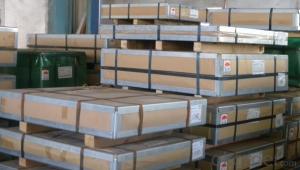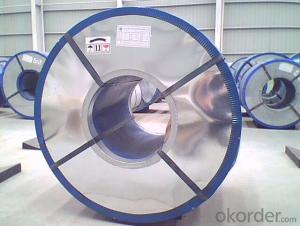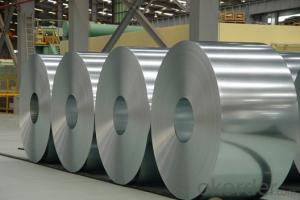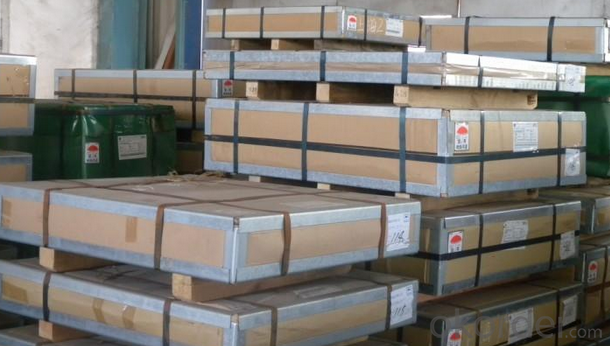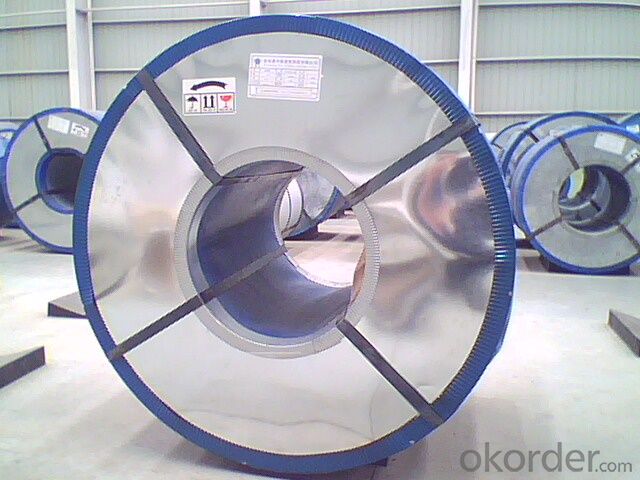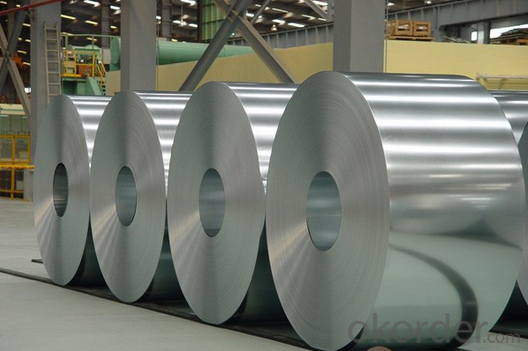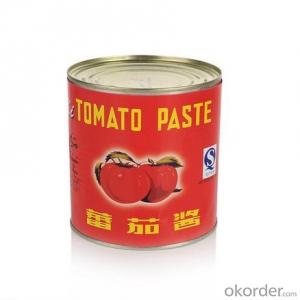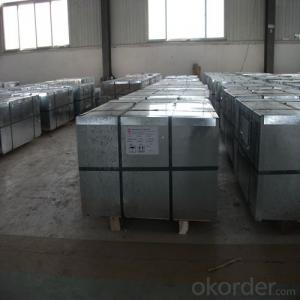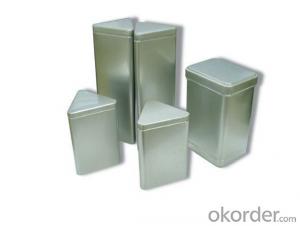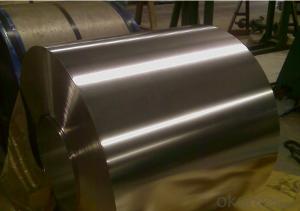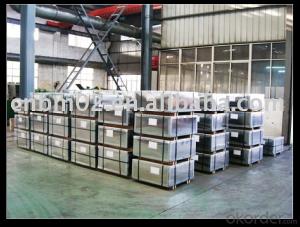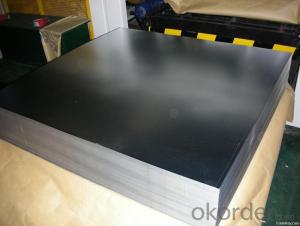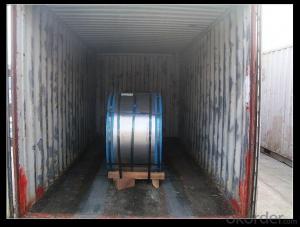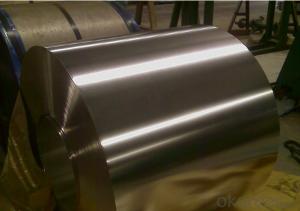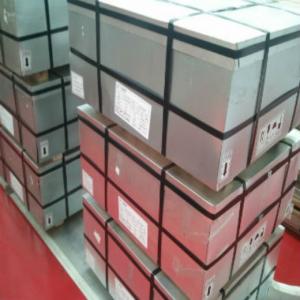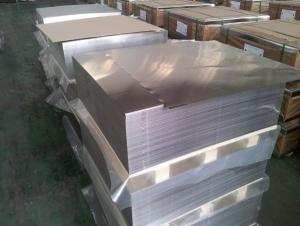Tinplate Coils / Sheets for Foods Packaging
- Loading Port:
- Tianjin
- Payment Terms:
- TT or LC
- Min Order Qty:
- 25 m.t
- Supply Capability:
- 7000 m.t/month
OKorder Service Pledge
OKorder Financial Service
You Might Also Like
Tinplate Coils / Sheets for Food Packaging
Product Description:
Due to Tinplate packaging’s excellent seal, nature, robustness and unique decorative metal charm, it has a wide range of uses in the packaging container industry, and is common in international packaging varieties. With a variety of CC tinplate materials, DR materials, and chrome plated, it is constantly promoted and developed.
Because of its strong antioxidant and diverse styles, beautiful printing, tinplate containers are very popular and loved by customers, and they are widely used in food packaging, pharmaceutical packaging, commodity packaging, instrumentation, packaging, and industrial packaging and much more.
With the continuous improvement of tinplate printing technology and processing technology, tinplate packaging has developed widely.
Product Advantages:
· The salient feature of DR Tinplate is the combination of higher strength and sufficient ductility, which enables much thinner Tinplate to be used, compared to Single Reduced Tinplate resulting in Substantial economic savings.
· According to the steel chemistry and annealing process, the second reduction (DR08) can be between 27% to 40%, thereby producing strengths up to 550 +/-50 N/mm², whereas single reduced material has strength less than 450 N/mm² &DR 09 (Hard DR) is produced at temper mill with reduction % in range of 27-35 % & will strength up to 690 N/mm² to the produced material.
Product Applications:
Product Specifications:
Standard | ISO 11949-1995, GB/T2520-2000, JIS G3303, ASTM A623, BS EN 10202 |
Material | MR, SPCC |
Thickness | 0.15mm - 0.50mm |
Width | 600mm - 1150mm |
Temper | T1-T5 |
Annealing | BA & CA |
Coil Inner Diameter | 508mm |
Weight | 6-10 tons/coil 1~1.7 tons/sheets bundle |
Passivation | 311 |
Oil | DOS |
Surface | Finished, bright, stone, matte, silver |
Product Images:
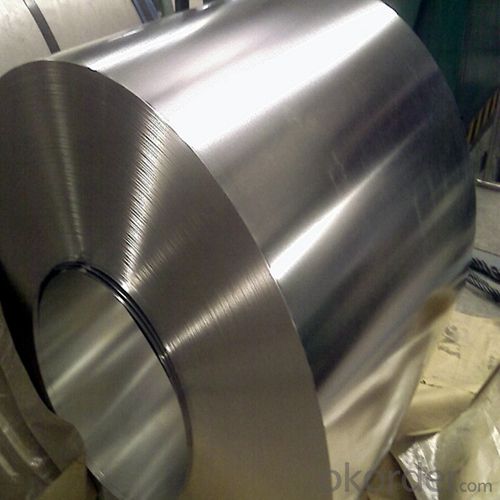
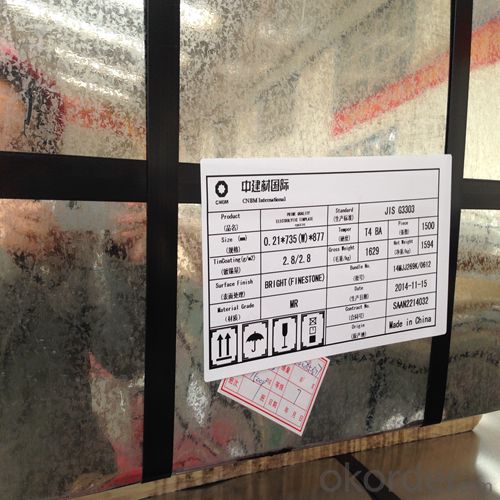
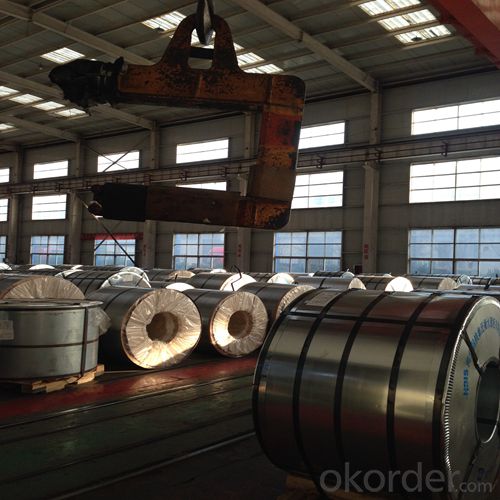
FAQ:
Q1: Why buy Materials & Equipment from OKorder.com?
A1: All products offered by OKorder.com are carefully selected from China's most reliable manufacturing enterprises. Through its ISO certifications, OKorder.com adheres to the highest standards and a commitment to supply chain safety and customer satisfaction.
Q2: How do we guarantee the quality of our products?
A2: We have established an advanced quality management system which conducts strict quality tests at every step, from raw materials to the final product. At the same time, we provide extensive follow-up service assurances as required.
- Q: How does tinplate compare to stainless steel in terms of properties and applications?
- Tinplate and stainless steel differ significantly in terms of properties and applications. Tinplate, made by coating thin steel sheets with a layer of tin, offers good corrosion resistance and malleability, making it suitable for applications like food and beverage packaging, cans, and aerosol containers. On the other hand, stainless steel, an alloy of steel with chromium and other elements, provides superior corrosion resistance, strength, and heat resistance. It finds extensive use in industries like construction, automotive, kitchenware, and medical equipment. While tinplate is more cost-effective and suitable for lightweight applications, stainless steel offers higher durability and versatility for various demanding applications.
- Q: How is tinplate coated?
- Tinplate is coated through a process called electroplating, where a thin layer of tin is applied onto the surface of steel or iron. This is done by immersing the metal into an electrolyte solution along with a tin anode and passing an electric current through the setup. The electric current causes tin ions to be attracted to the metal surface, forming a protective coating of tin on both sides of the tinplate.
- Q: Can tinplate packaging be used for personal care products?
- Yes, tinplate packaging can be used for personal care products. Tinplate is a suitable material choice for packaging personal care products such as lotions, creams, and cosmetics due to its durability, resistance to corrosion, and ability to protect the contents from external factors such as light and moisture. Additionally, tinplate packaging can be easily customized and decorated to enhance the product's appeal.
- Q: How does tinplate affect the taste and quality of food?
- Tinplate is commonly used in the packaging of food due to its protective properties. It acts as a barrier against air, moisture, and light, preventing contamination and spoilage of the product. However, tinplate can potentially affect the taste and quality of food if there is any interaction between the metal and the food. This can occur when acidic or salty foods come into contact with the tin coating, leading to a metallic taste. To prevent such issues, tin coatings are often lined with a layer of enamel or lacquer to create a barrier between the food and the metal. Additionally, strict regulations and quality control measures are in place to ensure that tinplate used in food packaging is safe and does not compromise the taste or quality of the food.
- Q: What are the hygiene benefits of tinplate packaging?
- Tinplate packaging offers several hygiene benefits, including providing a protective barrier against external contaminants, preventing cross-contamination, and preserving the quality and freshness of the packaged products. Additionally, tinplate packaging is resistant to corrosion, ensuring the integrity of the packaging and its contents.
- Q: Can tinplate be used for medical or pharmaceutical packaging?
- Yes, tinplate can be used for medical or pharmaceutical packaging. Tinplate is a type of steel coated with a thin layer of tin, which provides excellent protection against corrosion and contamination. It is durable, lightweight, and can be easily sterilized, making it suitable for packaging drugs, medical supplies, and other pharmaceutical products. Additionally, tinplate offers good barrier properties against moisture, oxygen, and light, ensuring the preservation and integrity of the packaged contents.
- Q: Can tinplate be used for packaging non-food items?
- Yes, tinplate can be used for packaging non-food items. Tinplate is a versatile material that is commonly used for packaging various products, including cosmetics, pharmaceuticals, chemicals, and other non-food items. Its durability, corrosion resistance, and aesthetic appeal make it a suitable option for packaging non-food items.
- Q: What are the main applications of tinplate in the aerosol industry?
- Tinplate is primarily used in the aerosol industry for manufacturing aerosol cans and containers. Its main applications include packaging of various aerosol products such as paints, lubricants, adhesives, and personal care products like deodorants and hairsprays. Tinplate cans ensure product safety, resist corrosion, and provide an excellent barrier against oxygen and moisture, making them ideal for preserving the integrity and longevity of aerosol contents.
- Q: What is the purpose of tin coating on tinplate?
- The purpose of tin coating on tinplate is to provide a protective barrier against corrosion, as tin is highly resistant to oxidation. Additionally, the tin coating enhances the appearance of the tinplate and allows for easy soldering, making it suitable for various applications such as food packaging and decorative items.
- Q: How is tinplate coated for aerosol cans?
- Tinplate is coated for aerosol cans through a process called electrolytic tin coating. In this process, a thin layer of tin is deposited onto the surface of the tinplate by immersing it in a bath of tin solution. The tin coating provides a protective barrier against corrosion and ensures the cans remain durable and airtight.
Send your message to us
Tinplate Coils / Sheets for Foods Packaging
- Loading Port:
- Tianjin
- Payment Terms:
- TT or LC
- Min Order Qty:
- 25 m.t
- Supply Capability:
- 7000 m.t/month
OKorder Service Pledge
OKorder Financial Service
Similar products
Hot products
Hot Searches
Related keywords
